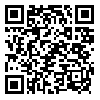Volume 80, Issue 10 (January 2023)
Tehran Univ Med J 2023, 80(10): 825-834 |
Back to browse issues page
Download citation:
BibTeX | RIS | EndNote | Medlars | ProCite | Reference Manager | RefWorks
Send citation to:



BibTeX | RIS | EndNote | Medlars | ProCite | Reference Manager | RefWorks
Send citation to:
Eshagh Hossaini S K, Hakimelahi J, Aghaali M, Mehrabi Z, Karimi Matlob R, Karimi Matlob S. Investigating factors affecting the response to
treatment in patients with ITP. Tehran Univ Med J 2023; 80 (10) :825-834
URL: http://tumj.tums.ac.ir/article-1-12114-en.html
URL: http://tumj.tums.ac.ir/article-1-12114-en.html
Seyed Kamal Eshagh Hossaini1 
 , Javad Hakimelahi1
, Javad Hakimelahi1 
 , Mohammad Aghaali2
, Mohammad Aghaali2 
 , Zahra Mehrabi1
, Zahra Mehrabi1 
 , Rasool Karimi Matlob3
, Rasool Karimi Matlob3 
 , Saeed Karimi Matlob *
, Saeed Karimi Matlob * 
 4
4

 , Javad Hakimelahi1
, Javad Hakimelahi1 
 , Mohammad Aghaali2
, Mohammad Aghaali2 
 , Zahra Mehrabi1
, Zahra Mehrabi1 
 , Rasool Karimi Matlob3
, Rasool Karimi Matlob3 
 , Saeed Karimi Matlob *
, Saeed Karimi Matlob * 
 4
4
1- Department of Pediatrics, Hazrat Fatemeh Masoumeh Educational and Therapeutic Center, Faculty of Medicine, Qom University of Medical Sciences, Qom, Iran.
2- Department of Social and Family Medicine, Faculty of Medicine, Qom University of Medical Sciences, Qom, Iran.
3- General Practitioner, Student Research Committee, Faculty of Medicine, Arak University of Medical Sciences, Arak, Iran.
4- General Practitioner, Student Research Committee, Faculty of Medicine, Qom University of Medical Sciences, Qom, Iran.
2- Department of Social and Family Medicine, Faculty of Medicine, Qom University of Medical Sciences, Qom, Iran.
3- General Practitioner, Student Research Committee, Faculty of Medicine, Arak University of Medical Sciences, Arak, Iran.
4- General Practitioner, Student Research Committee, Faculty of Medicine, Qom University of Medical Sciences, Qom, Iran.
Abstract: (903 Views)
Background: Idiopathic thrombocytopenic purpura (autoimmune), the most common cause of acute onset of thrombocytopenia in children who are otherwise healthy. This study was conducted with the aim of investigating the factors affecting the response to treatment in hospitalized children.
Methods: This retrospective study was conducted by examining the files of patients hospitalized due to ITP in Hazrat Masoumeh (S) Hospital from April 2009 to March 2019. The criteria for inclusion in the study included confirming the diagnosis of ITP and the age of 1 month to 14 years, and the exclusion criteria included cases of discharge with personal consent and not completing the patient's treatment course, the presence of pancytopenia or bicytopenia, the presence of moderate or severe splenomegaly or severe in clinical examinations, BMA based on the presence of a diagnosis other than ITP, not receiving any of the ITP treatment protocols, and patients whose first visit with the diagnosis of ITP was in another center or city. The information about age, sex, clinical symptoms on arrival, initial platelets and the platelets of days 3, 5, 14 and 180 were extracted from the patients' files. The type of treatment protocol, the need to repeat the treatment, the recurrence of the disease and the major complications of the treatment were extracted from the patients' files and finally the data were analyzed with SPSS software.
Results: The response to the treatment on different days was unrelated to the age, gender, and initial platelets (except for one exception) (P>0.05). In relation to clinical symptoms, the response to treatment on days three and five was related to the clinical symptoms at the time of presentation and on days 14 and 180 it was unrelated. Response to treatment on days 3 and 5 in different treatment protocols had a significant relationship (P<0.05), but there was no significant difference on days 14 and 180.
Methods: This retrospective study was conducted by examining the files of patients hospitalized due to ITP in Hazrat Masoumeh (S) Hospital from April 2009 to March 2019. The criteria for inclusion in the study included confirming the diagnosis of ITP and the age of 1 month to 14 years, and the exclusion criteria included cases of discharge with personal consent and not completing the patient's treatment course, the presence of pancytopenia or bicytopenia, the presence of moderate or severe splenomegaly or severe in clinical examinations, BMA based on the presence of a diagnosis other than ITP, not receiving any of the ITP treatment protocols, and patients whose first visit with the diagnosis of ITP was in another center or city. The information about age, sex, clinical symptoms on arrival, initial platelets and the platelets of days 3, 5, 14 and 180 were extracted from the patients' files. The type of treatment protocol, the need to repeat the treatment, the recurrence of the disease and the major complications of the treatment were extracted from the patients' files and finally the data were analyzed with SPSS software.
Results: The response to the treatment on different days was unrelated to the age, gender, and initial platelets (except for one exception) (P>0.05). In relation to clinical symptoms, the response to treatment on days three and five was related to the clinical symptoms at the time of presentation and on days 14 and 180 it was unrelated. Response to treatment on days 3 and 5 in different treatment protocols had a significant relationship (P<0.05), but there was no significant difference on days 14 and 180.
|
Conclusion: The best response was in the combined treatment group with methylprednisolone and IVIg, and the lowest response to treatment was observed in those receiving methylprednisolone alone.
|
Type of Study: Original Article |
| Rights and permissions | |
 |
This work is licensed under a Creative Commons Attribution-NonCommercial 4.0 International License. |



